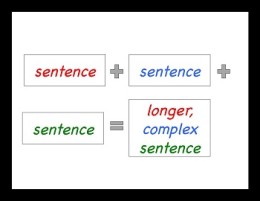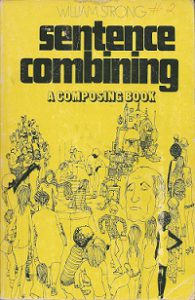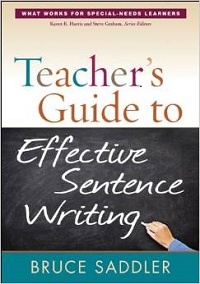Sentence Combining

I have long been a fan of sentence combining activities as a meaningful and effective way of improving students’ writing skills. Since the 1960’s, research studies have shown that sentence combining is an effective way to teach grammar to students in elementary through college levels and improves student writing. This is especially so for students who struggle with writing. The Writing Next report (2007) based on Graham and Perin’s meta-analysis of writing instruction research, identified sentence combining as one of the eleven most effective instructional practices for improving the writing of students in grades 4-12.
 I first started using sentence combining in the 1970’s while teaching reading and writing skills to students with learning disabilities. Back then, I discovered the first edition of a book by William Strong titled Sentence Combining: A Composing Book. I’ve included an image of the book cover in this post (notice the bell-bottom pants!). The book contained sets of simple sentences that students combined into longer, more complex sentences. Here are some simple examples from the 1973 book:
I first started using sentence combining in the 1970’s while teaching reading and writing skills to students with learning disabilities. Back then, I discovered the first edition of a book by William Strong titled Sentence Combining: A Composing Book. I’ve included an image of the book cover in this post (notice the bell-bottom pants!). The book contained sets of simple sentences that students combined into longer, more complex sentences. Here are some simple examples from the 1973 book:
- French fries are loaded into a basket.
- The French fries are white.
- The basket is wire.
Suggested Combination: White French fries are loaded into a wire basket.
- Then they are lowered.
- The lowering is slow.
- The lowering is into oil.
Suggested Combination: Then they are slowly lowered into oil.
Here is a more complicated example that was generated from science classroom text. The example is from the Quick Writes chapter of Keys to Content Writing.
- Wildlands are lands.
- The lands are public.
- The lands are private.
- The lands support native ecosystems.
- The lands include landscapes.
- A grazed rangeland is a landscape.
- Active timberland is a landscape.
Suggested Combination: Wildlands are public or private lands that support native ecosystems and landscapes such as grazed rangeland.
My students typically wrote sentence fragments or run-ons and had weak punctuation skills. At first I had to provide a lot of guided instruction and think aloud as they manipulated, rearranged, and combined words, but I saw firsthand how continued practiced gradually improved their ability to express themselves in longer, more complex sentences. I also noticed that their reading comprehension of text containing complex sentences seemed to improve. I was sufficiently intrigued by this to choose sentence combining as the topic for a research review in 1980 while studying for my Masters degree in reading. Low and behold, by 1980 research studies had begun to show that sentence combining practice improved reading comprehension.
Sentence combining is different from traditional grammar instruction of the type that was popular during the 1950’s and ‘60’s. Having started elementary school during this time period, I personally remember class lessons devoted to memorizing definitions of parts of speech and diagramming sentences. However, a number of studies have found that this type of grammar instruction isn’t helpful (see Writing Next noted above). It may be because these activities are disconnected from actual writing, as opposed to sentence combining.
Here are some sentence-combining resources:
Websites:
- Intervention Central: Sentence Combining
- The Well-Crafted Sentence and Its Importance for the Writer
- About education: Introduction to Sentence Combining
Books:
- William Strong’s first and second edition of Sentence Combining: A Composing Book are no longer in print, but the 3rd
 edition (1995) still is (McGraw-Hill).
edition (1995) still is (McGraw-Hill). - The book I recommend all the time related to sentence combining and other related instructional practices is Bruce Sadler’s Teacher’s Guide to Effective Sentence Writing (2012, Guilford Press).
- Another resource (but more expensive than the Sadler book) is Sentence Combining Workbook, 4th Edition by Altman, Caro, Metge-Egan, and Roberts (2013, Cengage Learning).
For many struggling writers, their problems start at the basic sentence-writing level. To learn more about this and how one school changed their sentence-writing instructional practices, I highly recommend this fascinating article that recounts the experience of students and teachers at New Dorp High School in New York – The Writing Revolution, by Peg Tyre (October, 2012, The Atlantic). Like many large, urban high schools, New Dorp had huge numbers of students who struggled with literacy skills, and they determined that many of these students could not express themselves at the sentence level. The school embarked on a “Writing Revolution” that emphasized sentence-writing skills, including sentence combining, in all academic areas. The results were significant.
Finally, here’s a related website you might find helpful – NoRedInk offers free practice activities using written sentences to help students improve grammar skills. Teachers can develop online lessons that include practice activities for topics such as: subject-verb agreement, sentences and fragments, clauses and phrases, verb tense, pronoun agreement, capitalization, punctuation (e.g. commas, apostrophes) and specific parts of speech.
Reference:
Graham, S., & Perin,D. (2007). Writing next: Effective strategies to improve writing of adolescents in middle and high schools – A report to Carnegie Corporation of New York. Washington, DC: Alliance for Excellent Education.
Leave a Reply
2 Comments
Trackbacks/Pingbacks
- The Writing Revolution - Keys to Literacy - […] of students across all grade levels, including in college. Visit a previous blog I wrote about Sentence Combining. Also,…

 Joan Sedita is the founder of Keys to Literacy and author of the Keys to Literacy professional development programs. She is an experienced educator, nationally recognized speaker and teacher trainer. She has worked for over 35 years in the literacy education field and has presented to thousands of teachers and related professionals at schools, colleges, clinics, and professional conferences.
Joan Sedita is the founder of Keys to Literacy and author of the Keys to Literacy professional development programs. She is an experienced educator, nationally recognized speaker and teacher trainer. She has worked for over 35 years in the literacy education field and has presented to thousands of teachers and related professionals at schools, colleges, clinics, and professional conferences.
I’m looking for an assessment which effectively provides progress monitoring on sentence construction. Ideally it would include grammar identification, sentence identification through sentence combining and expansion for student 2-5. Got any ideas? I’ve googled for hours and found nothing.
I believe one of the sub-tests in the Lexia RAPID assessment measure syntactic awareness, but I don’t know of any other formal assessment. For informal, formative assessment, you can give students sentence combining tasks and in an informal way determine if students are making progress in terms of how many sentences they can successfully combine.